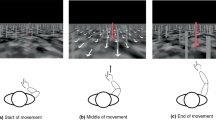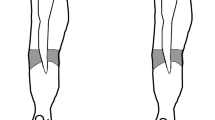Abstract.
How do humans achieve the precise positioning of the feet during walking, for example, to reach the first step of a stairway? We addressed this question at the visuomotor integration level. Based on the optical specification of the required adaptation, a dynamical system model of the visuomotor control of human locomotor pointing was devised for the positioning of a foot on a visible target on the floor during walking. Visuomotor integration consists of directly linking optical information to a motor command that specifically modulates step length in accordance with the ongoing dynamics of locomotor pattern generation. The adaptation of locomotion emerges from a perception–action coupling type of control based on temporal information rather than on feedforward planning of movements. The proposed model reproduces experimental results obtained for human locomotor pointing.
Similar content being viewed by others

Author information
Authors and Affiliations
Additional information
Received: 25 July 2001 / Accepted in revised form: 11 March 2002
Rights and permissions
About this article
Cite this article
de Rugy, A., Taga, G., Montagne, G. et al. Perception–action coupling model for human locomotor pointing. Biol Cybern 87, 141–150 (2002). https://doi.org/10.1007/s00422-002-0325-2
Issue Date:
DOI: https://doi.org/10.1007/s00422-002-0325-2



